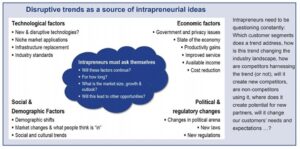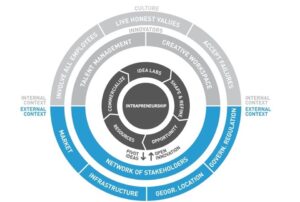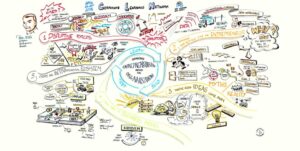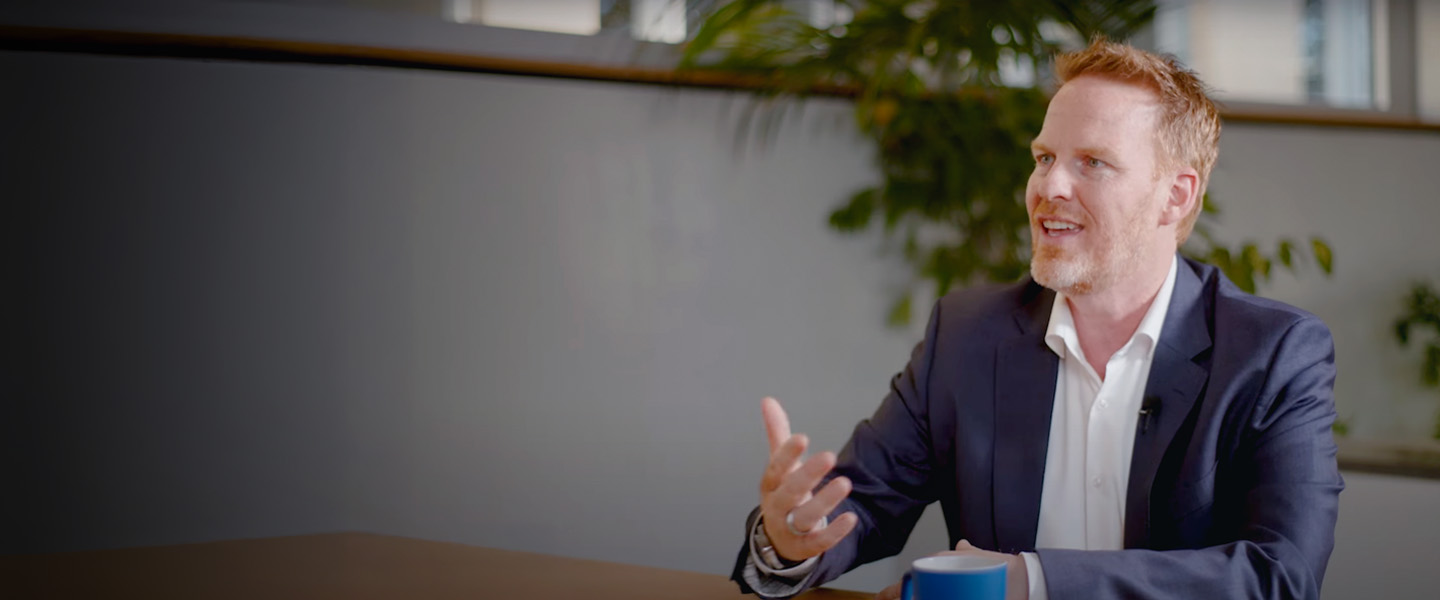Almost 50 participants attended a Discovery Event to gain insights into fostering entrepreneurial thinking across their organization. Being intrapreneurial – that is applying entrepreneurial skills and techniques inside an established organization – is back on the agenda of top management teams. They need to anticipate change and disruption in an agile and entrepreneurial way in order to survive the storm. In a number of hands-on sessions, participants worked on concrete business opportunities for disrupting their own industry and challenged each other, as well as conventional wisdom on innovation, to unleash their inner entrepreneur.
While we’ve always lived in a VUCA world – Volatile, Uncertain, Complex and Ambiguous – these tendencies are a bit more pronounced than in the past, with the speed of disruption exceeding anything seen before. New entrants are pushing innovative products or services onto the market and leveraging novel business models to disrupt entire industries. Many of these new players no longer own assets, but instead leverage existing assets and capture value from data and from controlling the customer interface.
Despite their significant market dominance and availability of resources, established businesses are increasingly uncertain about the future and struggle to adjust to this new reality. As a result, many have missed out on new growth opportunities because of their inability to match the speed of execution of new entrants. They realize they need to anticipate disruption and understand emerging technologies that may impact their business before it is too late.
But how to do so? It requires VUCA leadership – Vision, Understanding, Clarity and Agility, all of which are essential for a novel and entrepreneurial organization. The fundamental question is, how can established firms adopt entrepreneurial thinking and acting?
Watch out for cockroaches
Fast-moving start-ups can seem like an obvious threat to incumbents – the media is full of hype about unicorns, like Ant Financial and Uber, that have reached valuations of at least $1 billion in the space of a few years. But less well-known cockroach start-ups – often ignored by their competitors – may present an even greater hazard. A cockroach start-up is characterized by resourceful and resilient founders who survive no matter what. They are good at adapting to their environment and put the emphasis on revenues as well as profits, ensuring tight cost control to secure robust growth.
Thinking and acting like an entrepreneur
Are all entrepreneurs super heroes? Are entrepreneurs born or made? Is there such a thing as entrepreneurial DNA?
These are some of the questions asked when it comes to better understanding entrepreneurship and “the entrepreneur.” The current view of entrepreneurs is that there is no such thing as an entrepreneurial gene (this view might change in the future with the possibility to do large-scale genome studies), but there are certain personality and psychological traits that make them who they are. They have a strong desire for independence, a striking need for achievement and strongly believe that they have control over the outcome of events in their lives (so-called internal locus of control). They are disproportionately risk tolerant. Contrary to popular belief, entrepreneurs do not seek more risk, but they have a higher ability to deal with uncertainty.
Another critical aspect of entrepreneurs is that they see opportunities where others see problems. They are gifted at seeing potential commercial opportunities in everything they do (the analogy being that everything they touch turns to gold). Entrepreneurs can imagine possible new ends using a given set of means, and then follow unconventional paths to achieve their goals (so-called effectual thinking). Above all, they are persistent. So, can executives switch from their typical causal thinking to this type of effectual thinking?
Such a shift of perspective is easier said than done. Organizational adaptation requires a balance between respect for what has thus far been achieved and openness to change. Five principles of effectual thinking can help managers navigate this challenge effectively:
- Bird in the hand principle: Create opportunities and perform actions based on the resources available here and now.
- Affordable loss principle: You should only invest what you are willing to lose.
- Lemonade principle: Mistakes and surprises are inevitable and can be used to look for new opportunities.
- Crazy quilt principle: Entering into new partnerships can bring the project new funds and new directions.
- Pilot in the plane principle: Focus only on activities within your control.
Jumping the technology S-curve
The standard life cycle of innovations in most industries has been described as an S-shaped curve. The technology S-curve illustrates all cycles of an innovation – from its introduction to its growth and, finally, maturity. Managers can use this tool to map and understand how technologies evolve and displace each other, and what effect this might have on their company (see Figure 1).
Large and well-established companies have considerable resources, but they also tend to have bureaucracy to match. This may slow down their innovative processes significantly. Furthermore, the innovative activities that companies need to undertake may differ at each stage of the technology S-curve. For example, technologies in their mature stage become increasingly vulnerable to substitute technologies. At this point, managers need to make seemingly irrational decisions and invest in a new technology with potentially lower performance, rather than in the technology with which they are already dominant.
Since the performance of a new technology improves rapidly, companies that invest early can avoid being left behind their competitors. But there is also the risk of failure. Hence, managers seeking to escape the point of diminishing returns of the technology S-curve should break their innovative projects into manageable chunks, splitting them by type of innovation: incremental versus radical. This can help them evaluate the various projects and predict how they might evolve over time. While creating iterations of innovative products, processes or services is fairly easy, pivoting to a radically new business model is a tougher challenge. So how can organizations win at disruptive innovation?
Disruptive innovation: From idea to market
Where do truly disruptive ideas come from? That’s the million-dollar question, which is evidently not easy to answer. However, there are some factors that enable the generation of truly novel ideas. Often, they occur at the intersection of three things: a strong market need (desirability), a novel or incredibly intuitive technology or system (feasibility) and a scalable and highly attractive business model (viability).
Good ideas take a while to incubate. Before they become useful, they may spend a long time – 2 or 3 years or even up to 20 – in the form of an intuition. Good ideas often come from a collision between different ideas that then form something bigger. Historically, systems that increase connectivity have been shown to be drivers of scientific and technological innovation. Managers should figure out a way to set up a system where ideas can mingle and swap, offering an easy way for colleagues to be in touch and “to borrow other people’s ideas” that might just complete the idea they are working on. But they should also leverage the external environment through open innovation, co-creation and crowdsourcing.

However, all the innovative ideas in the world are worth nothing if companies fail to implement them; and if the innovation is truly disruptive, the stakes are higher and the barriers even more daunting. In this context, it might be useful for managers to encourage their employees to embrace the lean start-up principles of building a minimum viable product (MVP), going out and testing it, learning from the feedback and adjusting their solution. This principle is based on the “fail fast and fail cheap” mindset, which in some cases can serve as a useful alternative to the traditional innovation mechanisms that remain behind closed doors until the perfect solution is finalized.
It is essential to take a holistic approach to intrapreneurship and to build an intrapreneurial ecosystem within the organization (see Figure 2).

Figure 2: Intrapreneurial ecosystem
Building a culture of intrapreneurship
Intrapreneurship can be defined as the application of start-up methods within a corporate environment. Building an intrapreneurial culture might be one of the toughest managerial challenges, but it is an essential part of dealing with change. Intrapreneurship facilitates multichannel interactions and helps reconcile bottom-up and top-down approaches to innovation [paywall]. Finally, it leads to an organic diffusion of innovative ideas within a company.
Companies that transform towards an agile and intrapreneurial culture are more likely to develop radical innovations in-house. Promoting employees from the position of project manager to intrapreneur (possibly with some sort of stake in the initiative) can spur their dedication and passion for the job. However, managers should remember to design an appropriate reward and incentive structure, as well as a mechanism to spin radical innovative projects back into the company from the “innovation lab.” Often a successful new initiative fails when it comes back inside the business as it is placed into structures of the past.
While an entrepreneur develops a business from start to finish, an intrapreneur (sometimes referred to as a diplomatic rebel) has a focused role in an established company, working to solve an issue within the business. Typically, an intrapreneur has more directly applicable skills to perform certain tasks than an entrepreneur and is exposed to more risks in the context of their job. Pinchot’s Ten Commandments of Intrapreneurship are:
- Come to work each day willing to be fired.
- Circumvent any orders aimed at stopping your dream.
- Do any job needed to make your project work, regardless of your job description.
- Find people to help you.
- Follow your intuition about the people you choose, and work only with the best.
- Work underground as long as you can – publicity triggers the corporate immune system.
- Never bet on a race unless you are running in it.
- Remember, it is easier to ask for forgiveness than for permission.
- Be true to your goals but be realistic about the ways to achieve them.
- Honor your sponsors.
Managers promoting intrapreneurship within their organization should apply three steps to establish solid foundations for a truly intrapreneurial culture within their company: (1) have a clear vision and honest company values; (2) embrace a culture that accepts failure; and (3) encourage employees to take ownership of their ideas and turn them into reality.
Leading intrapreneurs
Innovation is a complex process and it needs fearless leadership. That is, leadership that is not only determined to maximize existing profits through continuous improvements (exploitation) but also willing to explore beyond the existing core competencies (exploration).
Exploitation is a company’s ability to keep aligned and efficient in managing today’s business demands. It refers to the past, previous investments, existing customer relationships, and the like, which still generate profits. Exploration is a company’s ability to innovate beyond its own core competencies. Exploration refers to the future, new technologies, new markets.
Balancing exploitation with exploration is the art of reconciling opposing tensions. Leaders therefore need to be ambidextrous, i.e. be able to effectively exploit all investments made to date and build on these achievements by exploring new areas and opportunities to ensure future viability.
Research has found that a truly ambidextrous organization is the most effective approach for established firms to drive disruptive innovation. The best set-up appears to be that the disruptive innovation activities are positioned sufficiently outside the established firm, with their own culture, structures and processes, yet directly integrated with the top management team.
Key learnings
When building an intrapreneurial ecosystem, keep in mind:
- Each ecosystem is unique. Don’t try just to replicate other organizations’ innovation ecosystems.
- Put your USP first! What are your organization’s core competencies and goals for innovation? What type of innovation are you looking for?
- Holistic implementation is vital: It is not enough to simply establish an innovation lab somewhere – you really need to think through all the core dimensions from scratch and, most importantly, see how they are aligned with the overall vision and strategy of your innovation activities.
- Adopt a multi-stakeholder approach: Involve all the necessary stakeholders, both inside and outside the organization.
You need a “chief ecosystem officer” mandated to orchestrate the innovation ecosystem players within and outside the organization. This person or entity should report directly to the top management team. - Bureaucracy blocks innovation. You should facilitate, but don’t regulate!

Graphic illustration of the Discovery Event
Discovery Events are exclusively available to members of IMD’s Nexus.










